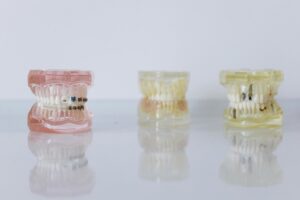
Orthodontic Treatment
Q1. What is Orthodontic Treatment?
Orthodontic treatment is a partnership between the orthodontist and the patient. The orthodontist provides custom made fixed or removable appliances that apply mild pressure over time to move teeth to their desired positions and the orthodontist recalls you once in 4 to 8 weeks.
There are certain responsibilities on the patient’s shoulders too like maintaining proper oral hygiene, precautions with the food you eat, keep scheduled orthodontic appointments so that the best results are achieved.
Q2. Why getting orthodontic treatment done is Important?
Orthodontic treatment helps ensure proper functions like proper chewing and speech and creates healthy, beautiful smiles. It is difficult to clean and maintain teeth that are malaligned. This in turn leads to plaque accumulation which further leads to more expensive and extensive problems like tooth decay and gum problems.
Q3. Why to get your treatment done only from an Orthodontic Specialist?
An orthodontic specialist is a dental professional with an extensive 3 years of rigorous training (MDS orthodontics) in addition to BDS degree. He has the skills and expertise to best treat orthodontic problems. Aligning teeth to function properly and look beautiful, too, is what an orthodontic specialist does best.
Q4. What causes Orthodontic Problems?
The cause of most of the problems – such as crowding, spacing, protrusion, extra or missing teeth and some jaw growth problems is genetic inheritance. Some other problems can be due to deleterious habits like thumb- or finger-sucking, dental disease, trauma, the early or late loss of milk teeth or other causes.
Q5. When should child get His/Her first check-up?
The best time for treatment is when an orthodontic problem arises, but as a general rule, according to the American Association of orthodontists aged 7 is an ideal time to get an evaluation. There is usually an optimal time in your child’s life to achieve the best results, so you won’t regret getting an orthodontic treatment early consultation from an orthodontic specialist.
Q6. At what age can treatment be done?
It’s never too late or you are never too old to get a beautiful smile through orthodontic treatment. Adult patients almost constitute half of the case load for any orthodontic practice. Also getting a beautiful smile in working adults will give them a boost in their social and professional sphere.
Q7. How long does treatment take?
It depends on the severity of the case and what the patient wants to achieve. An orthodontic treatment can last for 6 to 12 months for a mild case while a more complex case may take up to 18 to 24 months. The exact duration of the treatment will be explained after an oral examination.
Braces can correct a wide range of dental problems such as crooked, gapped, rotated or crowded teeth. There are several types of braces, including traditional metal braces, ceramic braces and clear aligners. Braces improve your teeth’s appearance, function and overall health of your teeth.
Q8. How do braces work?
Braces use mild constant force to move the teeth to correct positions over a period. The exact way of how this happens depends on the type of braces.
The types of braces are as follow:

1. Metal or Traditional Braces
Traditional metal braces are stainless steel brackets which are bonded to teeth for correcting their position. Nowadays even conventional metal braces have become more comfortable with smaller bracket size. The orthodontist after placing braces on teeth, places a thin wire through each of these brackets. These wires are activated or changed after 4 to 8 weeks as per the case requirement. Wire activation will apply a gentle pressure that moves teeth gradually into alignment.

2. Ceramic or Clear Braces
Ceramic Braces are meant typically for the adults and teens who want less visible braces or clear/tooth-coloured braces. Most of the people can’t even notice that you are wearing ceramic braces. a tooth-coloured wire is used along with ceramic braces to make it look more inconspicuous.

3. Self Ligating Braces
These braces can be either made of metal like traditional braces or from ceramic material like clear braces. The difference from the previous ones is that in these type of braces elastic bands are not used to tie the wire into the brackets. Instead, these have special type of clips to hold the wire in place with a mild pressure. Their advantages are they are more comfortable, have less friction, better oral hygiene maintenance and therefore, treatment is much faster as compared to the conventional ones.

